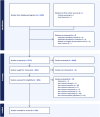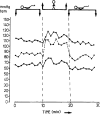Maternal posture-physiology interactions in human pregnancy: a narrative review
- PMID: 39100275
- PMCID: PMC11294255
- DOI: 10.3389/fphys.2024.1370079
Maternal posture-physiology interactions in human pregnancy: a narrative review
Abstract
There are several well-known medical conditions in which posture and gravity interact with natural history, including pregnancy. In this review, we provide a comprehensive overview of interactions between maternal posture and maternal physiology and pathophysiology at rest during pregnancy. We conducted a systematic literature search of the MEDLINE database and identified 644 studies from 1991 through 2021, inclusive, that met our inclusion criteria. We present a narrative review of the resulting literature and highlight discrepancies, research gaps, and potential clinical implications. We organize the results by organ system and, commencing with the neurological system, proceed in our synthesis generally in the craniocaudal direction, concluding with the skin. The circulatory system warranted our greatest and closest consideration-literature concerning the dynamic interplay between physiology (heart rate, stroke volume, cardiac output, blood pressure, and systemic vascular resistance), pathophysiology (e.g., hypertension in pregnancy), and postural changes provide an intricate and fascinating example of the importance of the subject of this review. Other organ systems discussed include respiratory, renal, genitourinary, gastrointestinal, abdominal, and endocrine. In addition to summarizing the existing literature on maternal posture-physiology interactions, we also point out gaps and opportunities for further research and clinical developments in this area. Overall, our review provides both insight into and relevance of maternal posture-physiology interactions vis à vis healthcare's mission to improve health and wellness during pregnancy and beyond.
Keywords: gravity; maternal; obstetrics; pathophysiology; physiology; posture; pregnancy.
Copyright © 2024 Kember, Anderson, Gorazd, House, Kerr, Torres Loza, Reuter, Hobson and Goergen.
Conflict of interest statement
Author AK was employed by Shiphrah Biomedical Inc. The remaining authors declare that the research was conducted in the absence of any commercial or financial relationships that could be construed as a potential conflict of interest.
Figures




Similar articles
-
Impact of maternal posture on fetal physiology in human pregnancy: a narrative review.Front Physiol. 2024 May 17;15:1394707. doi: 10.3389/fphys.2024.1394707. eCollection 2024. Front Physiol. 2024. PMID: 38827993 Free PMC article. Review.
-
[Standard technical specifications for methacholine chloride (Methacholine) bronchial challenge test (2023)].Zhonghua Jie He He Hu Xi Za Zhi. 2024 Feb 12;47(2):101-119. doi: 10.3760/cma.j.cn112147-20231019-00247. Zhonghua Jie He He Hu Xi Za Zhi. 2024. PMID: 38309959 Chinese.
-
Common sleep disorders in pregnancy: a review.Front Med (Lausanne). 2023 Aug 21;10:1235252. doi: 10.3389/fmed.2023.1235252. eCollection 2023. Front Med (Lausanne). 2023. PMID: 37671402 Free PMC article. Review.
-
Student and educator experiences of maternal-child simulation-based learning: a systematic review of qualitative evidence protocol.JBI Database System Rev Implement Rep. 2015 Jan;13(1):14-26. doi: 10.11124/jbisrir-2015-1694. JBI Database System Rev Implement Rep. 2015. PMID: 26447004
-
Dietary glycation compounds - implications for human health.Crit Rev Toxicol. 2024 Sep;54(8):485-617. doi: 10.1080/10408444.2024.2362985. Epub 2024 Aug 16. Crit Rev Toxicol. 2024. PMID: 39150724
Cited by
-
A new frontier for positional therapy: obstetrics.J Clin Sleep Med. 2025 Jul 1;21(7):1319-1320. doi: 10.5664/jcsm.11616. J Clin Sleep Med. 2025. PMID: 40110630 Free PMC article. No abstract available.
References
-
- Ahmad H. R., Akhtar S., Khan M. A., Khan K. S., Qureshi A. A., Romana H., et al. (1996). Dynamic and steady state response of heart rate to orthostatic stress in normotensive and hypertensive pregnant women. Eur. J. Obstet. Gynecol. Reprod. Biol. 66 (1), 31–37. 10.1016/0301-2115(96)02387-1 - DOI - PubMed
Publication types
Grants and funding
LinkOut - more resources
Full Text Sources
Miscellaneous

